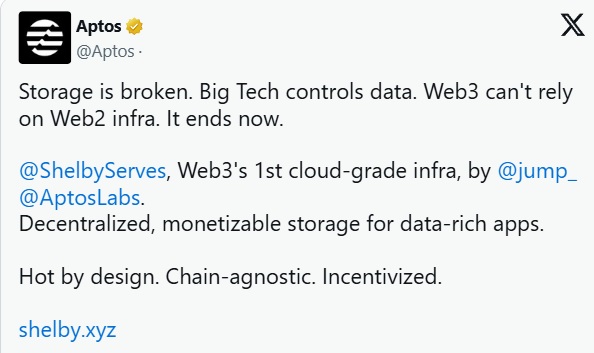Jump Crypto & Aptos Launch Shelby: Decentralized Cloud Infrastructure for the Future of AI and Web3
As artificial intelligence (AI) continues to transform the digital landscape, the demand for fast, scalable, and decentralized infrastructure is rising. Recognizing this need, Jump Crypto and Aptos Labs have jointly introduced Shelby, a high-performance decentralized storage network tailored for real-time applications. More than just an alternative to AWS or Google Cloud, Shelby signals the return of crypto veterans to the forefront of Web3 innovation.
What Is Shelby? A Decentralized Hot Storage Network
Shelby is not your typical decentralized storage protocol. Unlike cold storage solutions like Filecoin or Arweave that specialize in backups and static blockchain snapshots, Shelby focuses on “hot” programmable storage—ideal for dynamic, high-frequency applications such as:
- AI data pipelines
- Video streaming platforms
- Real-time social media feeds
- DePIN (Decentralized Physical Infrastructure) systems

Built atop the fast and efficient Aptos node network, Shelby enables millisecond-level read speeds, programmable access controls, and modular billing systems (including micro-tipping and digital rights management). It’s designed to be blockchain-agnostic and fully composable, supporting not just Aptos but also Ethereum, Solana, and eventually other modular chains.
From Cold to Hot: Redefining Web3 Storage
Shelby introduces a new concept: hot, programmable storage—where data isn’t just passively stored, but actively monetized, updated, and permissioned in real time. Use cases include:
- Dynamic NFT content delivery
- Real-time community wall updates
- AI training datasets with version control
- Live streaming with instant access rights
This evolution allows decentralized storage to break through previous limitations and unlock use cases previously reserved for centralized cloud platforms.
Jump Crypto’s Return: A Strategic Infrastructure Play
Once a stealth powerhouse in crypto—known for its involvement in high-frequency trading, DeFi protocols, and venture investments—Jump Crypto faced setbacks after the Terra, FTX, and Wormhole debacles. These events triggered significant financial losses and legal scrutiny, prompting a more cautious public stance.
However, Shelby marks Jump’s re-entry into foundational Web3 infrastructure, this time with renewed focus. From tokenized services and fiber-optic DePINs to decentralized exchanges like Sui DEX, Jump’s recent moves suggest a deliberate pivot back to building essential primitives.
As crypto commentator @dov_wo noted, Shelby is not merely a product launch—it’s a symbolic turning point, potentially restoring confidence in the crypto industry’s long-term viability.
Developer First: Shelby’s Launch Timeline and Ecosystem Support
Shelby is expected to debut its developer Devnet in Q4 2025, followed by a public beta phase. The first implementation will use Aptos as the coordination layer, with compatibility already planned for Ethereum and Solana. Modular blockchain integration is also on the roadmap.
Pranav Raval, Head of Engineering at Aptos Labs, emphasized that Shelby is purpose-built to empower next-gen decentralized apps in:
- Artificial intelligence
- Video/media streaming
- Social engagement
- DePIN and real-world data use cases
Shelby’s programmable storage paradigm offers developers a powerful foundation to build truly decentralized, performant applications.
Conclusion: A Decentralized Cloud Era Begins
The launch of Shelby reflects a broader shift in Web3—from speculative tokenomics toward robust, user-centric infrastructure. As traditional cloud providers remain centralized and permissioned, projects like Shelby offer a compelling alternative: a sovereign, composable, and performance-driven storage layer fit for the AI and Web3 era.
With Shelby, Jump Crypto and Aptos are not just building storage—they’re redefining how decentralized data infrastructure should work in the future internet.

![[News] Bitcoin at a Turning Point? 10x Research Signals a Bullish Macro Shift Ahead](https://cryptoexplores.com/wp-content/uploads/2025/06/new20250616.jpg)
![[News] Binance Lists $HOME, the Gas-Free, Bridge-Free All-in-One DeFi App](https://cryptoexplores.com/wp-content/uploads/2025/06/news20250617.jpg)